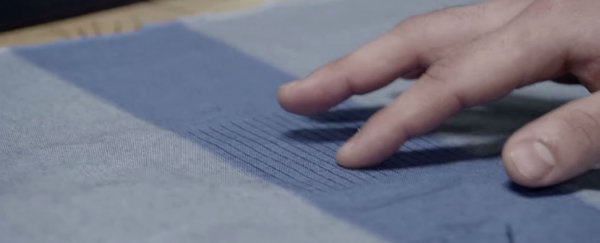Last week Google unveiled a wealth of new innovations and initiatives at its annual I/O developer conference, and one of the big reveals was Project Jacquard. It's part of the Google ATAP (Advanced Technology and Projects) division and it's the company's plan for the future of clothing: touch-sensitive materials that you can interact with in the same way as your smartphone display.
Project Jacquard uses touch-sensitive, metallic yarns that are weaved in with normal material - cotton, silk or polyester - to give it the kind of capabilities that you don't usually find outside of science fiction movies. The yarn is connected to a small receiver and controller the size of a button, with the idea that one day you might be able to tap your lapel to switch on the washing machine, or flick your cuff to change the volume on your smart television set.
One of the demos that Google showed off at I/O 2015 was a touch-enabled outfit controlling a set of Philips Hue lights. A quick tap on the clothing turned the lights on and off, while swiping left and right changed the colour, and swiping up and down adjusted the brightness. You wouldn't have to take your phone out of your jeans pocket to do all this - the pocket itself would act as the controller.
Monitoring capabilities can be included too, so your pillow could track your breathing or your t-shirt could monitor your heart rate without the need for any other equipment. Google is expecting to work with a number of different partners on the technology in the future, and already has an agreement in place with denim manufacturer Levi Strauss & Co in the US.
What makes the technology so exciting is its invisibility. There's no need to wear a clunky headset or a smart wristwatch to get connected - it's essentially the ultimate in wearables. Project Jacquard is still at the early stages, but a lot of progress has been made in a short space of time, and Google thinks the interactive yarn will have an important role to play in our sartorial future.
"The complementary components are engineered to be as discreet as possible," explains the official Project Jacquard page. "We developed innovative techniques to attach the conductive yarns to connectors and tiny circuits, no larger than the button on a jacket. These miniaturised electronics capture touch interactions, and various gestures can be inferred using machine-learning algorithms."
The smart clothing is stretchable and washable, and Google says it's up to the designer whether the special yarn is highlighted on the material or kept completely invisible. It can be restricted to a certain patch of clothing or spread over the whole garment.
Jacquard, by the way, is a type of loom used in the 19th century. Google says that the new touch-enabled clothing can be made at scale using equipment that already exists, so when it's ready for the mass market it can be cheaply and easily produced.
Ultimately, we could see all kinds of smart clothing, furnishings and textiles that look identical to the 'dumb' versions that came before them. Google doesn't have a timescale for launching Project Jacquard out into the world just yet, but you can sign up for updates at the project page.
